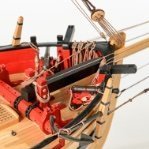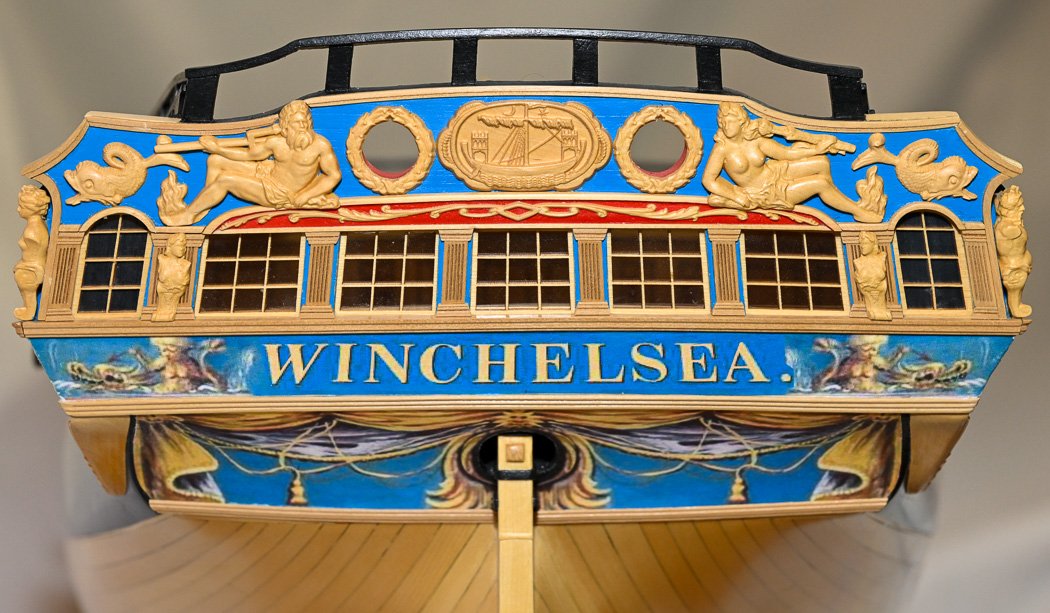-
Posts
4,111 -
Joined
-
Last visited
Content Type
Profiles
Forums
Gallery
Events
Everything posted by glbarlow
-
Interesting, you started 9 months later than I did and have now past me by. You’ll be done in no time.
- 389 replies
-
- winchelsea
- Syren Ship Model Company
-
(and 1 more)
Tagged with:
-

Does This Wood Model Ship Have Any Monetary Value?
glbarlow replied to jtridexter's topic in New member Introductions
I doubt you could give it away as is, not a particularly interesting model and not at all well made -
Good call BE. The extra effort shows well, especially on a hull of this size but really on any hull.
- 648 replies
-
- Indefatigable
- Vanguard Models
-
(and 1 more)
Tagged with:
-

bulkhead bevels
glbarlow replied to Woodshipguy's topic in Building, Framing, Planking and plating a ships hull and deck
The diagram really isn't the right approach to fairing a hull. Maybe on older models to get the rough shape but you can't take too much off. The bulkheads need to be squared up and installed on the former then you sand the whole hull so a batten (long thin piece of work, like a skinny plank) fits smoothly on all the bulkhead front to back. One way to manage is sanding with rougher grades of sandpaper on a sanding block then finish with 220 grit. You don't want to lose the shape of the proper hull so for a beginner leave the back edge of the char on bulkheads forward of midships and the front edge on bulkheads from there to the stern. You'll have to further shape the bow and the stern, but that's entirely model dependent though the batten approach still applies. No way though do you want to carve off a bunch of any bulkhead with a blade before its on the former. There are a ton of build logs on this site that demonstrate fairing, check them out. -
Congrats on the successful octagonal work. I had other planes and never could do much with them, the Ibex finger plane is a work of art and make shaping mast and yards so much more a pleasant task. it was harder to draw the 7-10-7 reference marks than it was doing the actual cutting, something I'm sure you experienced as well. For what it's worth, the sweeps would only be open if in use and an actual sweep (oar) in them. My approach was to make all those little dudes and simply pin them on, requiring only a small drill bit to make the hole and mark the location, a touch of glue and they are there for life. My captain is opposed to rowing so he was fine with this approach. Granado is one of my earliest models and occupies a fond place in my memories, a lot of water past the bow since then. Yours is looking great.
-
Winchelsea took me six months, planking is fun stuff Your first planking is looking great, nice start!
- 648 replies
-
- Indefatigable
- Vanguard Models
-
(and 1 more)
Tagged with:
-
I’m building a high level model that takes a decent level of skill to complete from a design and parts I could never achieve otherwise. These port hinges for example, I could make 20 from a strip of brass, I made one today just to prove to myself I could. But I’d be disappointed taking a week (in my case) because I’d do them over and over to get 20 that looked nearly alike, cause that’s what I do. I’d much rather spend my time on more fun things, like head rails, capstans, chain pumps, pedestals, and ship’s stoves than fabricating 1/16th metal strips. (I did ‘scratch’ all the metal on Cheerful, not that I enjoyed that part). I of course admire those that can scratch build, such amazing work here on MSW. However Chuck has brought modeling to a level us mortals can achieve amazing high results, if we put the work in and don’t just slap it together. It still takes major effort, so scratch building or not I’m pretty happy about consistent believable port hinges from magic metal looking material. Now I’m going to go fabricate a bunch of split rings and eyebolts from some wire.
-

Dust masks and respirators.
glbarlow replied to Bill Hudson's topic in Modeling tools and Workshop Equipment
While I frequently use a standard dust mask, a respirator for the work we do in modeling seems a little over the top. -
The raised bulkheads sound exciting, though too late for me, and having been one that has broken a scroll work or two I can see the advantage. The challenge might how it matches up to the surrounding molding and not having seen it how it looks matched up to wood in general. I’d like to see it as the head rails someday, is that a place where this material vs. wood wouldn’t be an issue? (I can be your beta tester😊). Yes, the scroll work and stern decorations are certainly a game changer as are many other Winchelsea innovations. I get to see that every day. Can you make black port hinges with it, or pedestals- those things there are multiple of and challenging to made consistent copies.😊
-
It’s a tough question about being symmetrical or going for an improved look, one not easy to answer. On display only one side shows obviously but we as the builder know there is a difference. I’d recommend trying “bending the wrong way” method, once you learn it you’ll love the result. That’s second part of the process, the first are the tick strips, making it easier to understand where to start the taper and how much to cut from the plank for the taper and you’ll not need stealers. It takes longer, but it looks so much better. Perhaps blending the two methods so your other side is an improvement but still somewhat mirrors the first side. Also good call on the CA and how you applied it. I use CA medium for planking, edge gluing is never needed. You could even just spot glue about the distance between bulkheads and still be fine. One other suggestion is to consider a butt shift pattern, doesn’t matter how long or how spaced they are, just a consistent repeating pattern on where horizontal planks meet on your run bow to stern. That said, your planking is well done, boxwood is such a nice wood. Once sanded and finish applied you’ll have a very fine looking model. I’ll enjoy watching your progress on this excellent Vanguard model.
- 443 replies
-
- Indefatigable
- Vanguard Models
-
(and 1 more)
Tagged with:
-
Looking good Glenn, and I mean UK Glenn, not me😂
- 587 replies
-
- Indefatigable
- Vanguard Models
-
(and 1 more)
Tagged with:
-
I wasn’t all that sure about the paper friezes at first. After spraying them with fixative and now having applied them all with the recommended stick glue I’m happy with how they turned out. Short of hand painting, way beyond my skills, I think it’s the best answer. Yours, like your amazing planking, look absolutely great.
-
Thanks Kevin, Chuck makes that part a lot easier with his design. Thank you Jean Paul for saying so, I do try to share what I’ve learned, not sure how good it is but I try. Thanks for the kind words. My great grandfather was a stone cutter. He built a stone wall along a Kentucky highway famous for its many horse farms. The wall was built without any mortar, just the fit of the rocks. It still stands today and a historical landmark, they wouldn’t move it when they widened the road. Despite state sponsored effort no one knows how to duplicate it. So maybe I inherited some small part of that skill. Thanks Jim, I appreciate the comment and glad I can help as I’ve been helped. Thank you Dusan. I just go into to a zone, cut, bend, shape, cut, bend, shape….so fun. I still have so many to go. It’s worth it though, helps bring life and realism to our models.
- 840 replies
-
- winchelsea
- Syren Ship Model Company
-
(and 1 more)
Tagged with:
-
I seriously doubt it would carry a cutter at all, way too big, maybe a jolly boat towed behind. These were fast ships that mostly worked in local waters, a ships boat wasn’t essential would think. As you can see from the deck there is not really a place to easily store one.
- 113 replies
-
- Cheerful
- Syren Ship Model Company
-
(and 1 more)
Tagged with:
-
Simply outstanding! You are more than ready for a return to Winnie. It’s a huge investment, if you’d feel better starting over you should, if you can move forward from where you are you should do that. At any rate we await your return. I was glad I did Cheerful first, so much I learned there I’ve applied and built on now. I’m sure you have that same confidence!
- 113 replies
-
- Cheerful
- Syren Ship Model Company
-
(and 1 more)
Tagged with:
-
I really like the cherry, I came very close to doing the same thing. Having rigged just 12 carronades on Cheerful I know the time I spent doing it. You’ve done 28 and they all look exactly the same, no small feat! Very precise, very nice. Your lighting makes for fun and interesting photos. Such a great looking model, congratulations on chapter 6 and of course the work you’ve done well beyond that.
About us
Modelshipworld - Advancing Ship Modeling through Research
SSL Secured
Your security is important for us so this Website is SSL-Secured
NRG Mailing Address
Nautical Research Guild
237 South Lincoln Street
Westmont IL, 60559-1917
Model Ship World ® and the MSW logo are Registered Trademarks, and belong to the Nautical Research Guild (United States Patent and Trademark Office: No. 6,929,264 & No. 6,929,274, registered Dec. 20, 2022)
Helpful Links
About the NRG
If you enjoy building ship models that are historically accurate as well as beautiful, then The Nautical Research Guild (NRG) is just right for you.
The Guild is a non-profit educational organization whose mission is to “Advance Ship Modeling Through Research”. We provide support to our members in their efforts to raise the quality of their model ships.
The Nautical Research Guild has published our world-renowned quarterly magazine, The Nautical Research Journal, since 1955. The pages of the Journal are full of articles by accomplished ship modelers who show you how they create those exquisite details on their models, and by maritime historians who show you the correct details to build. The Journal is available in both print and digital editions. Go to the NRG web site (www.thenrg.org) to download a complimentary digital copy of the Journal. The NRG also publishes plan sets, books and compilations of back issues of the Journal and the former Ships in Scale and Model Ship Builder magazines.




